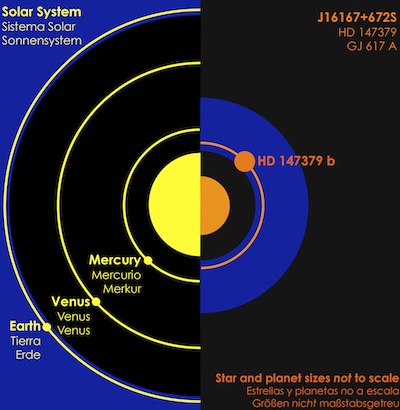The CARMENES instrument discovers its first exoplanet

The CARMENES project, promoted by a consortium of 11 German and Spanish institutions with contributions from the Institute of Space Studies of Catalonia, has discovered its first planet outside the Solar System from the 3,5 meter telescope of the Observatory from Calar Alto to Almeria, dependent on the CSIC and the Max Planck Society. The details of the finding are published in the Astronomy & Astrophysics Letters Magazine.
The instrument has observed a nearby dwarf star and half massive that the Sun, around which a planet named HD 147379 b is orbiting, slightly more massive than Neptune. This exoplanet completes its orbit every 86 days at a distance that is only a third part that separates Terra del Sol. The planet is within the so-called habitability zone, which is the region around a star where conditions allow the existence of liquid water.
"It is unlikely that life could have developed on this planet because it probably lacks a solid surface area," explains Ignasi Ribas, a researcher at the Institute of Space Sciences (ICE-CSIC) and director of the Institute of Space Sciences, Espacial Studies of Catalonia (IEEC). And he adds: "The exoplanet, similar to Neptune, and that orbits in the living area of a very close star, is not the most spectacular, but it is the first. We face a future of observations that, without a doubt, will bear fruit. "
A unique instrument
The discovery confirms the efficiency of CARMENES as an instrument designed to look for terrestrial planets in the habitability zone. "False positives are common in the search for extrasolar planets, and here one of the strengths of CARMENES emerges: observing in the visible and infrared we can confirm the findings without the need for other checks. No other instrument can do this, "says Pedro J. Amado, CSIC researcher at the Institute of Astrophysics of Andalusia and main co-investigator of CARMENES.
The instrument has been developed by a consortium of 11 Spanish and German institutions. In Spain, they participate in the project that will last at least until 2020, the Institute of Astrophysics of Andalusia (CSIC), which has raided the project and developed the infrared channel, the Institute of Space Sciences ( IEEC-CSIC), the Complutense University of Madrid, the Institute of Astrophysics of the Canary Islands and the Astrobiology Center (CSIC-INTA). He has obtained funding from the Max-Planck Society, the CSIC, the Ministry of Economy and Competitiveness and the Board of Andalusia, among other bodies.
A. Reiners et al. The CARMENES search for exoplanets around M dwarfs. HD147379 b: A nearby Neptune in an early-M dwarf's temperate zone. Astronomy & Astrophysics Letters. DOI: 10.1051 / 0004-6361 / 201732165
